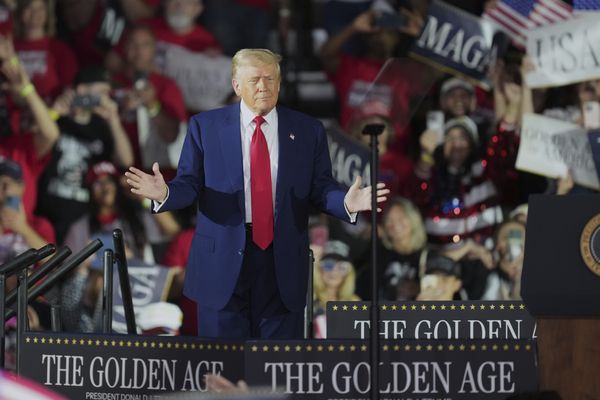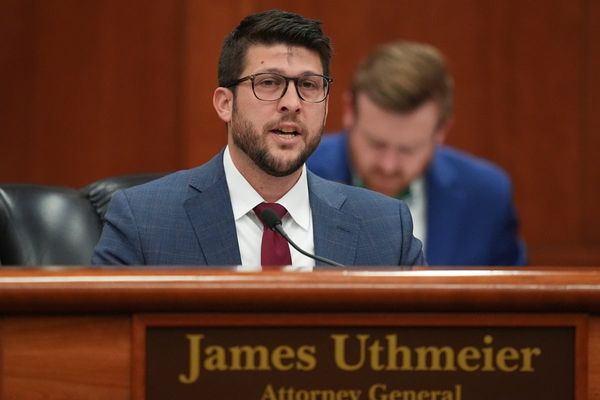
We’re still in the early days of President Trump’s second term, and it's uncertain how his economic policies and proposals will impact Americans’ retirement nest eggs. If you’re a retiree or have a 401(k) or IRA retirement account and you’re wondering what it all means for your bottom line, you’re not alone. Trump’s return to the White House means change is coming. As a result, whatever your age, your retirement planning strategy may need a rethink.
Trump’s impact is already being felt on Wall Street, which hates uncertainty. In mid-March, less than two months since Trump took office on Jan. 20, the benchmark S&P 500 stock index suffered its first decline of 10% or more since 2023, largely due to confusion and lack of clarity surrounding the implementation of Trump’s tariff plans. The Trump administration’s pledge to root out fraud and waste within Social Security and slash costs via job cuts and the closing of branches used by Social Security beneficiaries have also raised anxiety.
But it’s still too early to know for sure how your finances will be affected over the long term. Despite the Republicans’ sweep of Congress, the GOP has an extremely narrow House majority. And that means it’s still unclear if Trump can get enough votes in Congress to translate all his campaign pledges into policy. “There are a lot of moving parts that are difficult to anticipate,” said John Jones, investment advisor representative at Heritage Financial. “Time will tell what campaign policies will ultimately affect retirement, investment and income outcomes.”
On the campaign trail, Trump 2.0’s main pocketbook promises were to extend his 2017 tax cuts for workers and push for deeper tax cuts for corporations. Progress has been slow on the tax front, as GOP leaders hope to put forth a budget later this year to extend Trump’s tax cuts and fund other key provisions of his agenda.
Trump also pledged to protect Social Security, end inflation, lower everyday costs and make housing more affordable. To help pay for it all, Trump plans to boost revenue with his pro-growth platform and slap tariffs on foreign-made goods entering the U.S. Trump has enacted some tariffs on trading partners, threatened others and canceled and delayed others. The uncertainty of the impact of tariffs on companies and sectors of the economy has caused Wall Street economists to boost the odds of a recession or economic downturn.
It’s important to note that while presidential policies can move the economic needle, the president can't exert control over all the levers that make the economy and financial markets go. “The economic trends and forces that are in place are far more powerful than presidential policies,” says Ross Mayfield, investment strategist at Baird Private Wealth Management.
Trump could change your retirement
In short, there’s nothing to say that Trump can push through everything on his economic wish list. “We don’t really know what will actually come to fruition,” says Lindsay Theodore, thought leadership senior manager at T. Rowe Price. Still, Trump’s tax, tariffs, and immigration policies could all impact retirement portfolios, adds Theodore.
No doubt, Trump’s policies can have an impact — both positive and negative — on the nation’s retirement readiness.
“Based on conversations I’m having with clients now, it’s a mixed bag,” said Rachele Tubonganua, a private wealth advisor at U.S. Bank
Here are eight ways President Trump could change your retirement.
1. Lower taxes means more money to spend and save
If Wall Street is correct, and Trump can extend the Tax Cuts & Jobs Act (TCJA) of 2017, which expires at the end of 2025, Americans can avoid paying higher taxes and seeing their paychecks shrink. (If the TCJA is allowed to sunset, tax rates will revert to the higher rates before the legislation was passed.) This is one of the key items on Trump’s agenda that investors are watching. There’s still a feeling that lawmakers won’t let the tax cuts sunset. “I think everybody recognizes they can’t let that happen,” said Tim Steffen, director of advanced planning at Baird.
An extension of TCJA is a tailwind for spending. “Fewer taxes mean more money in your pocket,” says Chris Mediate, president of Mediate Financial Services. “This could enhance retirement savings, as retirement is always about the money you can keep from your income.” So, those are plusses for retirees on fixed incomes and pre-retirees still in the asset accumulation stage.
An extension of the TCJA would also mean that people have a longer runway to take advantage of the lower tax brackets, says Tubonganua. One strategy to consider is converting traditional 401(k) or IRA dollars into a Roth IRA, which allows for tax-free withdrawals. A similar option is to convert a traditional 401(k) into a Roth 401(k). The time is right now because with tax rates low, you’ll pay less taxes on the dollar amount you convert to a Roth account. “The narrative is to really minimize taxes in the future (when they are likely to be higher),” says Tubonganua. “You want to take advantage of opportunities that are available to you right now.”
2. Social Security: Angst over customer service now and potential cuts in the future
Trump vows to fight and protect Social Security. A March 11 press release reiterated the message that Trump “will not cut Social Security” but is focused on eliminating “waste and fraud” in the entitlement program to help shore it up. In the short run, that’s a plus, as those receiving Social Security checks can continue to count on 100% of their benefits. “I don’t think people have to worry about their checks,” says Mayfield.
Still, Trump is pushing to lower Social Security costs by trimming its employee count by 12% to 50,000 from 57,000 and shuddering nearly four dozen agencies. And that’s raising red flags from critics who argue beneficiaries will face added delays and longer wait times to speak with a Social Security representative.
“In terms of apprehension and worry, at the top of the list is a breakdown in timely service delivery,” says Richard Fiesta, executive director of the Alliance for Retired Americans. “Will there be sufficient resources to handle claims and resolve any issues about benefits either in person, online or over the phone?” Former Social Security Administration commissioner Martin O’Malley has publicly warned of an “interruption in benefits” due to system outages caused by the firing of experienced employees who know the system well.
Trump is also proposing to end taxes on Social Security benefits. Depending on a retiree’s income, up to 85% of benefits could be subject to taxes under current law. Doing away with taxes on benefits is a welcome break for retirees in the short term. “It makes Social Security benefits that much more valuable,” says Steffen.
But there’s a future downside: it’s a costly proposal that puts Social Security on even shakier ground. Ending taxes on Social Security means less revenue to cover future benefits. There’s a risk that it will pull forward the timetable when full benefits won't be paid, as Trump’s current policies don’t offer fixes to address Social Security’s weakening financial positioning.
Currently, Social Security recipients can expect to get 100% of their benefits through 2033. However, after that, unless Congress takes steps to shore up Social Security, the trust fund will be depleted, and the government will only be able to pay 79% of earned benefits thanks to ongoing Social Security payroll deductions from working Americans. “In 10 years, checks will be cut by 21% and nobody wants to see that happen,” said Theodore. “So, that’s a big concern that we’re watching closely.”
The Committee for a Responsible Federal Budget says that if Trump’s pledges to eliminate taxes on Social Security, tip and overtime pay, and tariffs on trading partners get passed, it would further widen the Social Security fund’s deficits and speed up the fund’s insolvency by three years.
Despite the uncertainty about the solvency of Social Security, “there haven’t been any real credible threats, at least as of now, targeting actual benefits,” says Matthew Allen, co-founder and CEO of Social Security Advisors, a firm that advises Americans on claiming strategies.
Theodore, the J.P. Morgan senior manager, still advises people to take Social Security later to lock in a larger lifetime benefit rather than panicking and taking benefits earlier at a reduced rate. “It’s about a 70% difference between your (benefit) paycheck at 62 versus waiting until age 70,” said Theodore.
3. How slashing corporate taxes could lift your 401(k)
Trump wants to lower the corporate tax rate from 21% to 15%. If he’s successful, the dollars that corporations avoid in taxes go right to their bottom line, which boosts their profitability. And corporate earnings are a key driver of stock prices. So, retirement savers who own stocks could see the value of their holdings in their 401(k) plans rise, says Baird’s Mayfield. Similarly, Mayfield says Trump’s push to reduce regulations on businesses to boost animal spirits also bodes well for stock investors. “They are all tailwinds for corporate profitability,” says Mayfield.
Adds Mediate: “When markets perform well, many retirement challenges are mitigated.”
On the negative side, however, inflation and interest rates could rise if Trump’s policies stoke too much growth. And that one-two punch could cause both the stock and bond markets to fall in value, reducing retirement account balances.
Theodore says an active management approach to investing could outperform during Trump’s next term. Portfolio managers are more nimble and can move more money into stock in sectors of the economy that will benefit from the new president’s policies and allocate less capital to sectors that will suffer.
There have also been rumblings in the private equity world that Trump’s preference for fewer rather than more regulations could pave the way for private equity investments to be allowed in employer-sponsored retirement accounts via target-date funds and other types of funds, according to a report in Pensions & Investments.
Private equity investments, which are not publicly owned companies that trade on the New York Stock Exchange or Nasdaq, tend to be less liquid investments (codeword for not as easy to sell). However, since retirement accounts are long-term investments, proponents of private equity say it could add more diversification and upside potential to retirement accounts.
“Over 99% of American businesses are private, and these investments allow people to participate in a much broader universe of opportunities,” says Michael Weisz, founder and CEO of Yieldstreet, an alternative investments platform. Moreover, a 2023 study by Georgetown University’s Center for Retirement Initiatives found that substituting a 10% private equity stake for publicly traded stocks in a portfolio netted a better median return of 0.22% per year and produced positive outcomes 80% of the time.
4. Tariffs could feed inflation, hurting Americans’ purchasing power
Trump's tax cuts and other programs will rely on revenue from a controversial source: tariffs. Upon taking office, one of his first actions was slapping 25% tariffs on Mexico and Canada, which were delayed and went into effect on March 4, 2025. On the campaign trail, Trump pledged to levy tariffs of up to 60% on China and 10% to 20% on other countries importing goods to the U.S.
Tariffs, however, could have an unintended consequence: They could cause inflation or increase consumer prices, which would result in higher interest rates if the nation’s central bank needed to tame inflation.
Both factors could put a dent in retirees' and working Americans' purchasing power. “The costs of tariffs will be passed on to the end consumer, so it ends up being somewhat of a sales tax,” says Theodore. “The dollar might not go as far for retirees on a fixed income," adds Theodore. Prices could go up for cars, dishwashers, and other consumer products. And a return to inflationary times would be a negative for all Americans, who are still hurting from the post-Covid spike in inflation that peaked at 9.1% in 2022, its highest level since 1981. Tariffs imposed by Trump in his first term as president also acted as a headwind for stocks, adds Mayfield.
Tariffs would also hit the economies of some states especially hard, particularly those in the Midwest and South.
5. Health care costs could rise
Part of the Inflation Reduction Act (IRA) passed by the Biden administration aimed to lower the out-of-pocket health-care costs for older adults, including capping the cost of insulin used to treat diabetes at $35 a month, capping out-of-pocket costs for prescription drugs at $2,000 per year for U.S. older adults, as well as reducing the cost of the first 10 drugs selected for Medicare price negotiation. The IRA expires at the end of 2025.
The Trump administration has already reversed pilot programs, such as $2 price caps on some prescription drugs for Medicare that the IRA does not cover.
Similarly, the Affordable Care Act (ACA) passed during the Barack Obama presidency made health care coverage affordable for 45 million Americans with the help of government subsidies and premium tax credits and the creation of the health insurance marketplace. The premium subsidies also expire after 2025 unless Congress acts. The risk, of course, is if a Republican-controlled Congress moves to repeal the IRA or doesn’t renew the ACA premium subsidies, says Theodore, who advises clients to watch this development closely, as it can have a huge impact on the affordability of health care.
“Health care is a big question mark,” says Patti Brennan, CEO of Key Financial. “It’s probably safe to assume those costs will increase for most people who are retired.”
6. Deportation of immigrants could have negative effects
Many of the undocumented immigrants that Trump is working to deport earn and spend money in the economy and are key sources of labor in agriculture, housing and other services, Theodore notes.
One potential downside is the cost of fruits and vegetables could rise, pinching the budgets of retirees and other Americans. What’s more, it could result in even higher costs for new homes and home renovations if labor costs rise as the supply of workers shrinks.
For retirees needing hired caregivers, Trump's policies to end some programs for legal immigration could reduce the number of home healthcare workers.
7. Market volatility could rise
As feared, Trump’s policies, many of which could feed inflation and increase investor uncertainty, have led to elevated financial market volatility, witnessed by the stock market’s first correction since 2023. If stock and bond prices suffer steep, lasting price corrections, retirement savers and retirees must ensure they have solid financial plans that allow them to ride out the storm. Getting spooked and making poor financial decisions due to fear will only make matters worse.
“The market prefers stability, right?” says Steffen. “It likes certainty.” Investors and retirees must not get caught up in the noise, says Steffen. “Don’t make long-term bets based on the latest proposal or talking point or tweet,” says Steffen.
8. Beware the "sequence of returns" risk
Retirees face the risk of a down market just as they enter retirement. The so-called sequence of returns risk is when retirees must take withdrawals from their retirement accounts when asset prices are depressed. The downside? It depletes your nest egg more quickly and forces you to sell more shares of what you own to raise the income you need. As a result, you have fewer shares to benefit from the eventual market rebound.
Research shows that if two portfolios have the same average annual returns over a long period of time, the one that suffers declines in the early years of retirement will be depleted more quickly than a portfolio that suffers a downturn years after a person enters retirement.
“(Recent) retirees definitely need to be aware of it,” says Nick Bour, founder and CEO of Inspire Wealth. “It can drastically reduce the timeline of how long your money will last. If the market is down 10% and you’re taking a 4% annual distribution, you’re down 14%.”
To protect yourself, it’s wise to have 6 to 12 to 24 months of cash available so you don’t have to tap your investments in a multi-year downturn. Another way to avoid a financial crisis is to play ahead of retirement and build a balanced portfolio so you don’t take too much of a hit. For example, a 50/50 mix of stocks and bonds means if the stock market is down 10%, your portfolio might only be down half of that, Bour says.
9. Gridlock may not be good this time around
The Republican sweep of Congress raised hopes that much of Trump’s campaign pledges would have a clearer path to becoming law. But the narrow GOP majority in the House could mean legislative gridlock.
Normally, Wall Street likes gridlock, because it means big changes are not forthcoming and the status quo remains intact. However, gridlock this time around could be negative, warns Steffen. Gridlock, for example, could mean the Tax Cuts and Jobs Act of 2017 could be allowed to sunset at the end of the year, causing Americans’ paychecks to shrink. It could mean Trump’s plans to make Social Security benefits tax-free doesn’t happen. In short, many of Trump’s proposals that are deemed as beneficial to many Americans might not come to fruition. “The very slim majority in the House means all it takes is one or two votes to change everything,” says Steffen.
Keep calm and carry on
Despite all the different ways a second Trump presidency could impact your money and retirement, the best advice is to stay the course and keep executing your financial plan, says Tubonganua. “Focus on your long-term plan and goals and objectives,” says Tubonganua. “Tweak it (your plan) here and there if needed once policies do come into play and impact your finances.”







